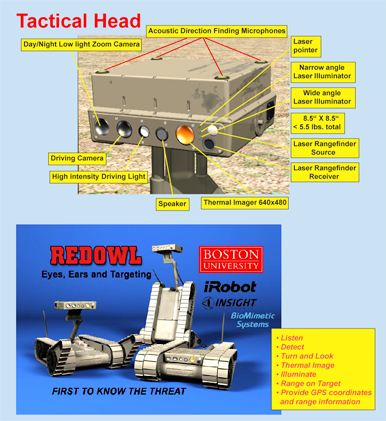BU technology is the brain behind new military robot prototype
Aural sensors distinguish sounds, types of gunfire

Technology developed at BU that is aimed at bringing sound to the profoundly deaf could soon be saving lives on the battlefield. A tactical sensor system developed at the Photonics Center in conjunction with iRobot of Burlington, Mass., Insight Technology of Londonderry, N.H., and the BU startup company BioMimetic Systems is being assembled for use on iRobot’s unmanned PackBot robots, models of which are now deployed in Iraq and Afghanistan.
The REDOWL, or Robot Enhanced Detection Outpost With Lasers, is a set of sensors compressed into a box the size of a book. Inside this box is a high-resolution television camera with 300x zoom, a wide-angle camera for peripheral vision, an infrared camera, and three lasers (a dot, a circular beam, and a floodlight), a laser rangefinder that can see up to three kilometers, or 1.86 miles, (farther on a good day), and a thermal imager.
The sensors can distinguish AK-47 fire from a 9mm pistol and pinpoint the origin of the sound. When attached to a PackBot, these systems enable the unmanned vehicle to accurately detect, locate, identify, and target moving ground vehicles and the origination points of fire. The robot was developed by iRobot, famous for its Roomba automatic vacuum cleaner. The optics in the sensor were developed by Insight Technology, and the sophisticated ears were developed by BioMimetic Systems, a company founded by Allyn Hubbard, a College of Engineering electrical and computer engineering professor, and David Mountain, an ENG biomedical engineering professor, at BU’s Hearing Research Center.
“Initially we were only thinking about medical applications,” says Socrates Deligeorges (ENG’96,’04), president of BioMimetic Systems, who invented the technology used in REDOWL. “We are specifically modeling human hearing, to make [a sensor] behave like a human being or an animal would behave.” Deligeorges earned a master’s and a Ph.D. in biomedical engineering from ENG and specializes in neural network processing, the technology that analyzes the patterns of sounds and is used in cochlear implants.
Glenn Thoren, deputy director of the Photonics Center, knows well the potential of the work being done at BioMimetic Systems. He helped connect iRobot, Insight Technology, and BioMimetic Systems. The project is the largest of several at the Photonics Center.
Developing and integrating the optical and aural sensors for REDOWL in time to meet military and federal funding deadlines required working with unprecedented intensity over a year and a half. “It was extremely fast,” Deligeorges says of the prototype development. “We worked 80-hour weeks for months at a time and some long 24-hour days.” Will it be worth it? “If it starts saving lives, I think it would,” Deligeorges says.
Thoren says REDOWL will give soldiers an entirely new system to “see and hear things in places they can’t get to or don’t want to be at.” It also has applications for homeland security, such as protecting nuclear power plants or airports. The prototype was well received at its first demonstration, says Thoren, on October 3 at the Association of the U.S. Army annual meeting in Washington, D.C., where iRobot staged an exhibition. “The two- and three-star generals who got to see it showed an enormous amount of interest,” he says.
As Deligeorges and his team work to integrate the REDOWL system into the PackBot, they are adding vocabulary to its brain: mortar fire and rocket-propelled grenades. On the medical side, Deligeorges says he will continue his postdoctoral research at the Hearing Research Center, striving to improve cochlear implant technology for the profoundly deaf, “until we can replace human hearing entirely.”